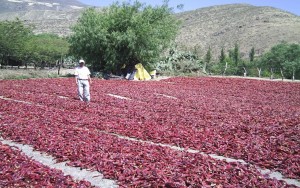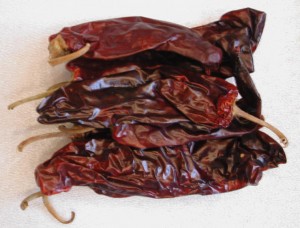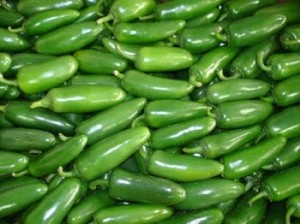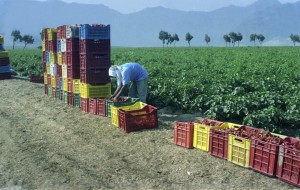Chiles are now Grown in Peru and Exported to Mexico


If there is anything more Mexican than guajillo chiles, reddish, spicy, and yet a bit sweet, or the green fire of jalapeños I do not know what it is. Yet, if you go to a market, local or super, in Mexico to buy them, chances are they come from China or Peru.
I found this out when I went to a Mexican wholesale market here in Salt Lake City, Utah, United States, after watching a Diana Kennedy video on YouTube.
Kennedy is the famous exponent of Mexican food in the Anglo world and increasingly within Spanish speaking Mexico. There is something decidedly curmudgeonly about her when, in the market she lectures the vendors on chiles. She complains that the Chinese versions of guajillos and jalapeños are not as good as the Mexican.
She holds up the Chinese and Mexican dried pods of guajillo side by side and points out the Mexican is softer and more fleshy. It has more of the essence that makes for a good sauce, the dried walls of the chile, between tough outer skin and seeds. She also claims the Mexican is far more flavorful, while the Chinese is less so, even though for reasons of price it is coming to dominate the Mexican market.
Kennedy also complained at length about so called “improvements” in other chiles, like jalapeños and others which make them larger, ostensibly more attractive, and much less flavorful.


On that point I can agree. Jalapeños in the US seem increasingly flavorless and have much less heat, it seems to me. The same can be said for the standbys of Mexican food in the US, the green chiles (called anaheim) and the poblanos, both used for stuffing among other things. From them comes the famous chiles rellenos without which it is hard to imagine Mexican restaurants in the United States. I have almost given up on the dish, though I have loved it since my childhood on the US Mexican border, because the peppers generally taste of water and little else. If you want the good flavor you have to find the right seed stock and raise them yourselves. I did not realize how bad, though attractive, the peppers had become in Mexico until hearing Kennedy’s rant in a Mexican market.
I was in the Mexican market looking at large bins of dried chiles, holding them up, feeling them and comparing them, to see if I could tell which were Mexican and which came from other countries, as Kennedy recommended. The market’s owner came up to see if I needed help.
I told him what I was doing and then he told me, in Spanish, that the peppers did not only come from China, now, they also come from Peru.
While he made sense, given Peru’s thrust to find non-traditional exports for new markets, and I already knew Peru was a major producer of tabasco peppers, making tabasco sauce strangely Peruvian now if not traditional, still I was in shock. If this had been one of the old Condorito cartoons you would have seen me fall backwards as the frame filled with “plop.”
So, I looked it up Sure enough, one of the largest producers of sugar cane and sugar products in Peru, the agroindustrial giant POMALCO, has gotten into the chile business. It now grows Mexican chiles in Lambayeque, a region most known for the Lord of Sipan and it exports them to the US and to Mexico.

Peru is negotiating a treaty with Mexico and other Pacific countries which will drop trade barriers and allow visa-less travel among them. This flow of Peruvian-grown Mexican chiles to Mexico to accompany Peruvian onions, asparagus, garlic, avocados, and so much more, is no doubt a preamble to this neo-liberal future of free trade. Yet it still surprises.
I do not really know why, though. Corn seems to have been domesticated in Mexico and yet quickly established itself in Peru where it became thoroughly native. Tomatoes, on the other hand, seem native to the Andes and yet became food in Mexico. There is even a Peruvian aji, the chile manzano known as in Peru as rocoto, that became thoroughly established in Mexico long before the negotiations of this trade agreement were even thought of. In Mexico you even find ceviche.
When I was in Cusco last, I talked to a man from Guadalajara, Mexico who was in Peru on business. He wanted to find good rocoto seed to take back to Mexico since he found the manzano peppers relatively mild.
Still, we live in a time when crops and dishes can be claimed by countries and food can seem to represent a people, a region, or a nation. The displacement of Mexican to Peru disconcerts.

But there are two other issues here: first, agroindustrial improvements that make food pretty, durable, and yet loses its flavor; and second, the issue of terroir, the raising of food in a particular climate and place that gives it a distinctive flavor and quality. On the last point, chiles are notoriously sensitive to where they are grown. The same seed stock grown in one place as opposed to another gives noticeably different flavor.
As if justifying itself by this and in recognition of the threat from the very “free” market Peru is throwing itself into when it competes with Mexico on guajillos, Peru is recognizing, branding, its own produce and giving them denominations of origin to bind the name to the place. It has already done so with the loche squash and the giant white corn from Cusco. It expects a market that depends of certifications of location versus a universal stock of food from anywhere.
That future is already now, when I have to carefully evaluate any guajillo chile, before I can make my enchiladas, to see if it is indeed from Mexico with the full flavor I expect, or whether it is from other places, China, and now Peru.
Diana Kennedy https://m.youtube.com/watch?v=2INapanYHF4




